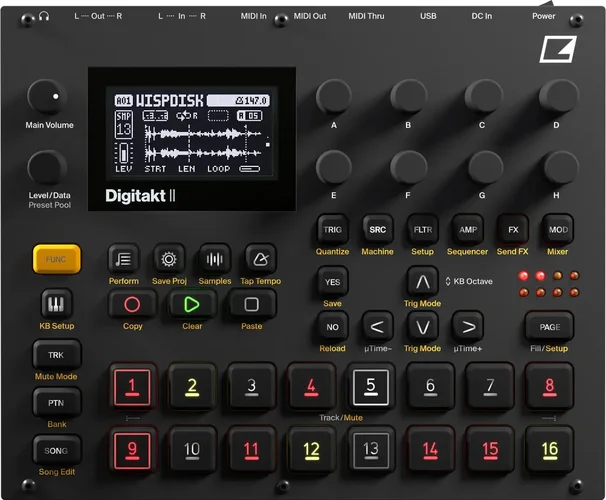Revolution bei Elektron - 8 Takte, 400 MB Samples, 16 Stimmen und Stereo. Durch Leak gab es schon eine Menge Information:
Darunter auch 20GB Platz intern, um eigene Samples zu verwalten.
Das sind die Eckdaten mit faktisch gleichem Äußeren aber viel viel sinnvollen Updates im Inneren mit einer Stimmenzahl, die sogar zuließe nur mit Digitakt II ganze Tracks zu bauen. Das ganze wird bei 1050€ liegen.
Bei allem anderen kennst du die Daten sicher schon - 3 LFOs, 3 Effekte (Delay, Hall, Chorus)
16 CCs sind festzulegen und pro Spur ist sie weiterhin 4stimmig.
Es gibt 5 FILTR Machines und ansonsten alles von Digitakt was man kennt. 2 Monoklinken pro Ein/Ausgang findest du auf der Rückseite. Also auch so wie man es erwartet.
Die 4 LEDs sind zu 8 angewachsen und damit ist endlich Moogulatorlänge erreicht Wie bei der Electribe SX - sicher bietet diese mehr Stimmen - noch immer, aber 16 sind ein Wort - und weil sie polyphon sind, muss man gut haushalten damit. Es ist nun doch eher eine Groovebox, denn von den Features war die "altere" Digitakt das bereits. Aber die neue Maschine macht alles in Stereo und ist damit im JETZT angekommen und braucht deshalb auch viel mehr Speicher, vorher war es 64 MB RAM und 1 GB Speicher für Samples - also weniger als die Hälfte, damit kommen sie der Sache nah.
Wie bei der Electribe SX - sicher bietet diese mehr Stimmen - noch immer, aber 16 sind ein Wort - und weil sie polyphon sind, muss man gut haushalten damit. Es ist nun doch eher eine Groovebox, denn von den Features war die "altere" Digitakt das bereits. Aber die neue Maschine macht alles in Stereo und ist damit im JETZT angekommen und braucht deshalb auch viel mehr Speicher, vorher war es 64 MB RAM und 1 GB Speicher für Samples - also weniger als die Hälfte, damit kommen sie der Sache nah.
Neben Werp und Co gibt es noch den "Grid" Modus. Der ist demnach auch neu? Grid ist neu? Nein, das ist einfach der Slice-Modus und damit bekannt. Vermutlich auch noch ohne Trimmung wie im Octatrack.
Es gibt eine große Ladung von neuen Funktionen, teilweise Kit Verwaltungen wie im Rytm, Bänke A-H für Samples (bisher nur eine Bank von 128 Samples) und Anzeige von Parameter-Locks als LED, in welchem Menü die Parameter statt finden.
Außerdem auf breiter Ebene jede Menge andere Bedienschritte, die man als komplette Überholung der Maschine sehen muss. Das wäre schon als Update für die alte Digitakt einiges Wert.
Die 16 Spuren werden verteilt, dh. es gibt nicht wie vorher 8 MIDI und 8 Sampleslots eine freie Wahl und damit 16 Samplespuren und jede davon kann ALTERNATIV eine MIDISpur sein. Das ist anders. Es gibt also nicht weitere 16 MIDI Spuren MIDI - sondern man wird wohl hier meist alle Spuren für Samples nutzen und für polyphone Spuren auch mal 2-3 MIDI Spuren setzen. So etwa. Links ist ein "Keyboard" Taster dazu gekommen und die Machines seit OS 1.5 sind nun auch so beschriftet. Die Machines sind auch verantwortlich ob es Slices oder andere Abspieltypen sind. Stretch zB zieht die Samples in das BPM Schema und ähnliches.
Aber - Digitakt bleibt eine Drummachine für 16 monophone Stimmen oder aber polyphone Linien die Stimmen kosten und damit auch Spuren.
MIDI Thru gibt es zum Glück noch immer, es ist also alles wie man es braucht.


Weiter geht es hier https://www.sequencer.de/synthesizer/threads/elektron-digitakt-2.170902/
Mit OS 1.03 läuft auch Overbridge wieder.
Overbridge mit Version 2.13
Darunter auch 20GB Platz intern, um eigene Samples zu verwalten.
Das sind die Eckdaten mit faktisch gleichem Äußeren aber viel viel sinnvollen Updates im Inneren mit einer Stimmenzahl, die sogar zuließe nur mit Digitakt II ganze Tracks zu bauen. Das ganze wird bei 1050€ liegen.
Bei allem anderen kennst du die Daten sicher schon - 3 LFOs, 3 Effekte (Delay, Hall, Chorus)
16 CCs sind festzulegen und pro Spur ist sie weiterhin 4stimmig.
Es gibt 5 FILTR Machines und ansonsten alles von Digitakt was man kennt. 2 Monoklinken pro Ein/Ausgang findest du auf der Rückseite. Also auch so wie man es erwartet.
Die 4 LEDs sind zu 8 angewachsen und damit ist endlich Moogulatorlänge erreicht
Neben Werp und Co gibt es noch den "Grid" Modus. Der ist demnach auch neu? Grid ist neu? Nein, das ist einfach der Slice-Modus und damit bekannt. Vermutlich auch noch ohne Trimmung wie im Octatrack.
Es gibt eine große Ladung von neuen Funktionen, teilweise Kit Verwaltungen wie im Rytm, Bänke A-H für Samples (bisher nur eine Bank von 128 Samples) und Anzeige von Parameter-Locks als LED, in welchem Menü die Parameter statt finden.
Außerdem auf breiter Ebene jede Menge andere Bedienschritte, die man als komplette Überholung der Maschine sehen muss. Das wäre schon als Update für die alte Digitakt einiges Wert.
Die 16 Spuren werden verteilt, dh. es gibt nicht wie vorher 8 MIDI und 8 Sampleslots eine freie Wahl und damit 16 Samplespuren und jede davon kann ALTERNATIV eine MIDISpur sein. Das ist anders. Es gibt also nicht weitere 16 MIDI Spuren MIDI - sondern man wird wohl hier meist alle Spuren für Samples nutzen und für polyphone Spuren auch mal 2-3 MIDI Spuren setzen. So etwa. Links ist ein "Keyboard" Taster dazu gekommen und die Machines seit OS 1.5 sind nun auch so beschriftet. Die Machines sind auch verantwortlich ob es Slices oder andere Abspieltypen sind. Stretch zB zieht die Samples in das BPM Schema und ähnliches.
Aber - Digitakt bleibt eine Drummachine für 16 monophone Stimmen oder aber polyphone Linien die Stimmen kosten und damit auch Spuren.
MIDI Thru gibt es zum Glück noch immer, es ist also alles wie man es braucht.


Weiter geht es hier https://www.sequencer.de/synthesizer/threads/elektron-digitakt-2.170902/
Mit OS 1.03 läuft auch Overbridge wieder.
Overbridge mit Version 2.13
Zuletzt bearbeitet: